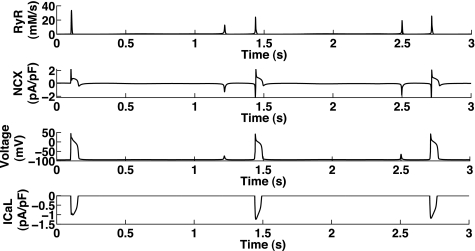Fig. 1.
Development of delayed afterdepolarizations (DADs) in a mathematical model (Noble98). Top to bottom: Ca2+current through ryanodine receptors (RyRs; A), current through the Na+/Ca2+ exchanger (NCX; B), cell membrane potential (voltage; C), and L-type Ca2+ current (ICaL; D). Shown is the Noble98 model under Na+ overload, which was found to produce Ca2+ oscillations and DADs (see text). The first action potential (AP; at 0.1 s) was produced as a result of stimulus current (after 1-Hz pacing), whereas the following depolarizations occurred as a result of Ca2+ release, where RyRs were activated by the increased Ca2+ within the cell. Note that the first and third DADs were not accompanied by enough membrane depolarization to activate fast Na+ current and ICaL, whereas the second and fourth DADs did (see differences in NCX), thereby producing full APs.

